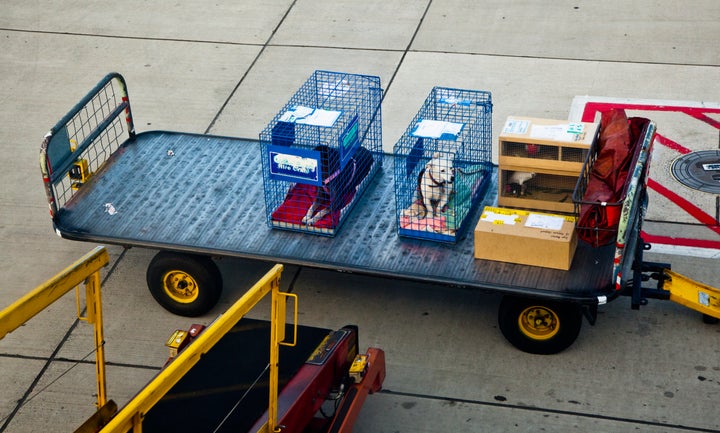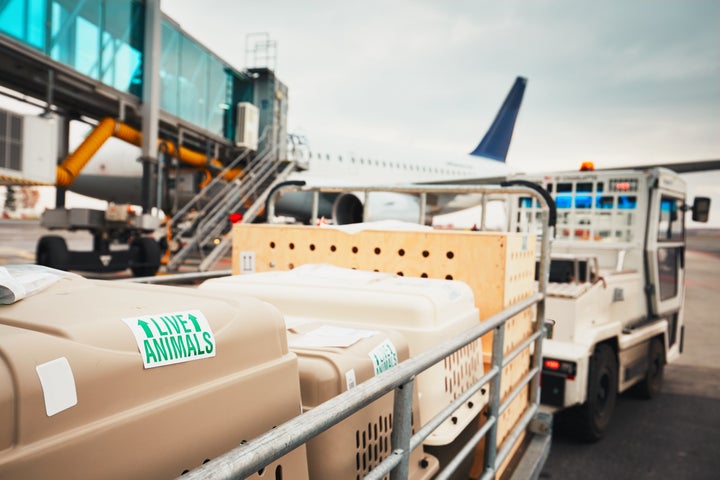Flying with pets can be hectic for owners and animals alike. Most airlines allow some small animals in the cabin, while those that transport larger dogs and cats require them to fly as cargo, usually under the cabin in a pressurized hold.
The latter isn’t always a paw-sitive experience. This week, a giant rabbit was found dead after a United Airlines flight from London to Chicago, according to its owner. The rabbit’s death is the latest awful mishap for United, with headlines noting it leads passenger airlines with the most animal deaths; there have been 53 over the last five years.
But animals face danger in the air no matter the carrier: From 2010 to 2012, Delta saw the highest number of pet fatalities with 41, and Alaska Airlines reported 12 pet deaths between 2012 and 2014, which high when taking into account their relatively low passenger traffic compared to airlines like United and Delta.
Here’s what you need to know to decide if and how to fly a pet.
How common is it for pets to die or suffer injury in flight?
Between 2012 and 2016, an average of 26 pets died on commercial flights every year, according to Department of Transportation statistics obtained by HuffPost. In 2016, there were a total of 26 deaths and 22 injuries among pet passengers. Injuries came mostly from animals biting or scratching at kennels while they traveled, and death reports note animals breathing heavily, collapsing or simply being “discovered deceased” upon landing. The majority of post-mortem exam results cite heart failure as the cause of death.

“It’s hard to say” exactly what causes pets to die during or immediately after flights, as every case is different, said Inga Fricke, director of pet retention programs at The Humane Society of the United States. There is, however, a higher overall risk for brachycephalic breeds like bulldogs and pugs, whose “short nasal passages leave them especially vulnerable to oxygen deprivation and heat stroke,” she said.
Where do pets go when they’re checked as cargo?
They’re loaded in kennels and stowed in the cargo area below the cabin. Pets are usually on the same flight as their owners, but sometimes scheduling will require pets to fly on different planes, a Delta representative told HuffPost. Though the cargo hold is pressurized, it’s often dark and noisy, with fluctuating temperatures and air pressure.
What’s it like in there?
Most airlines have time and temperature limits for transporting warm-blooded pets: American Airlines, for example, doesn’t allow pet travel if temperatures are above 85 or below 45 degrees Fahrenheit at any point in the itinerary. Delta’s minimum is 10 degrees Fahrenheit, and Alaska won’t fly pets if it’s extremely hot or cold, a spokeswoman confirmed to HuffPost. Some more sensitive breeds, like bulldogs and pugs, come with more restrictions: On United, these breeds can’t fly at all during summer months.
Pets are typically banned on flights longer than 12 hours.

Is this safe? Should I fly with my pet?
It’s best to consider all other options first, according to Fricke.
“Putting pets in cargo areas should be avoided whenever possible,” she said. “Once that animal is out of your control, there are so many risks it can be exposed to that it’s just not worth it.”
So far, it’s unknown what killed the giant rabbit that flew United. But experts say that airplane-related animal deaths can typically be attributed to the stress from waiting on loading ramps, coupled with extreme temperature and pressure changes on the tarmac and in the cargo hold, National Geographic reports.
The Humane Society recommends driving with your pet or leaving it behind during vacations. If you must fly with a pet, bring it in the cabin with you if possible, or do your homework and choose a trusted pet shipping service for larger cats and dogs. If you absolutely must check your pet as cargo, introduce it to its travel kennel a few weeks before the trip, notify cabin crew that your pet is flying as cargo and avoid giving it any sedatives before the journey, as they can backfire at high altitudes.